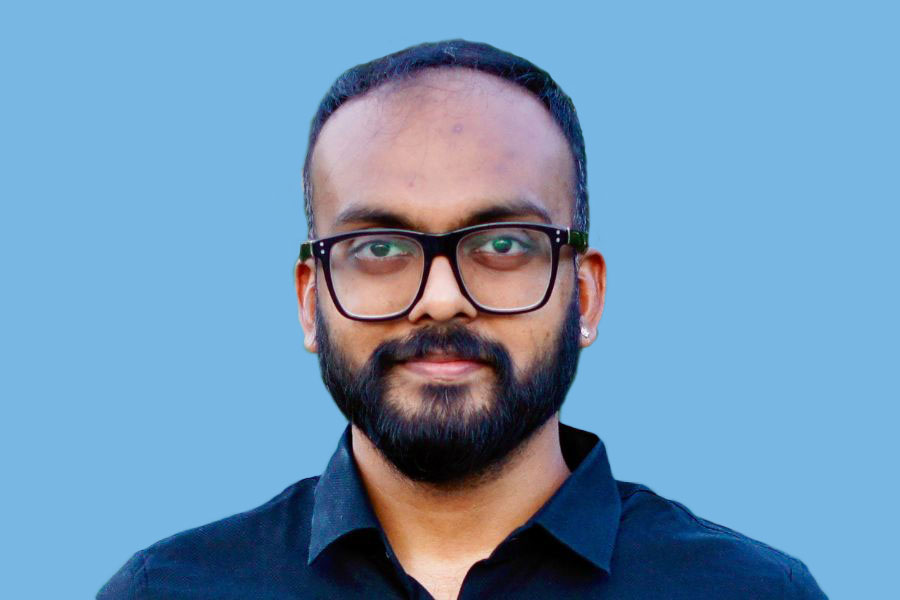“We plan to set up 18,000 Agrocrete manufacturing units by 2050”
India has set stiff targets for its carbon emissions, and its vibrant startup ecosystem undoubtedly has a major role to play. One such climate-conscious startup that is making waves in the building space is GreenJams.
Tarun Jami, the company’s founder and CEO, talks about his journey of innovation and enterprise, which led to the development of Agrocrete solid blocks, hollow blocks, and plaster. These carbon-negative and thermally insulating building materials are made out of crop residues and industrial byproducts. Going forward, the company intends to set up 18,000 manufacturing units for the product by leveraging the franchise mode.

Photo Source: Tarun Jami
IBT: Creating thermal insulating building blocks is one of a kind. Tell us about the technology behind Agrocrete’s innovation.
Tarun Jami: Our flagship innovation, Agrocrete®, is made using crop residues and byproducts of the steel and power industries. Globally, this is an upcoming class of building material that’s called vegetal concrete. Technologically, there are a few challenges that we need to solve before we put this into the market. Traditionally, vegetal concrete was always used for insulation and therefore they were always weak.
The most popular vegetal concrete was hempcrete. To further explain, hempcrete has been used as an insulation material and always had a very low mechanical standard. So, there would be challenges that we have to solve. So, over the coursework of 8 years, with the R&D in place, we developed an entirely new chemistry. On the basis of this, we are now able to create materials that are strong as conventional materials like burned clay, bricks, concrete and so on. But having said that, we need to scratch the surface, as it is very versatile.
Vegetal concrete is, as the name suggests, concrete, which can be used to make floors, walls or anything. The goal for the company is to advance this technology for two purposes. One, vegetal concrete is important as it is made from crop residuals to capture carbon dioxide. In a way, it is one of the most cost-effective methods for carbon capture and storage, simply because we have already used raw materials that capture carbon dioxide. Second, we use it due to the far-reaching social impact it has. We use crop residues and purchase them from farmers to create an additional source of income for them.
IBT: The concept of vegetal concrete is known globally. In India, what is its popularity and usage in comparison to the global market?
Tarun Jami: Agrocrete® is essentially a registered trademark of GreenJams. But this technique of creating building blocks has been around for quite a few centuries. The earliest recorded history of hempcrete was in France somewhere around 1,500 or 1,600 A.D. Even before that, hemp was used in our own Ajanta and Ellora caves. Using these blocks, you can build just about everything – from single-storey buildings to 40-50 storied skyscrapers. At this point, Agrocrete® is available in the form of hollow and solid blocks.
Globally, it is a significantly large industry. Recently, a report came out that estimated its growth at US$ 200 billion. India’s potential is around US$ 20 billion, and by 2030, we want to be doing US$ 5 billion of business at least in the country.
IBT: Agrocrete has two main ingredients – industrial and crop wastes. From where do you source these materials?
Tarun Jami: The sorts of waste that we are using are easily available. Anywhere you go, you will find fly ash because you are always going to have energy or power plants. Also, steel is always going to be one of the largest building materials because of its versatility. India is an agrarian country and still one of the largest employers. We have found raw materials everywhere, which are visible to our eyes, but we had not noticed.
So far, we have two manufacturing units. One is in Meerut (Uttar Pradesh) and another one is in Visakhapatnam (Andhra Pradesh), which has recently been commissioned. Before Meerut, we had operations in Roorkee, which was a very small setup. In both locations together, we have impacted around 100 to 150 farmers by procuring their crop residues. We have prevented approximately 500-600 tons of crop residues from burning within 1 year and paid out approximately Rs. 10-12 lakh to farmers.
IBT: What is the manufacturing process of creating Agrocrete?
Tarun Jami: For set up and manufacturing, the investment is approximately Rs. 1 crore in one acre of land. That is where the business model is interesting, because going forward, we don’t want to own any of these Agrocrete manufacturing units. The construction is so decentralized and it takes place all around the country. Essentially this material is to be manufactured locally and consumed locally. For that, you need to set up one manufacturing unit per Mandal. We will need around 18,000 manufacturing units across the country to address the construction demand. For that to happen we will need partnerships.
So, the goal is to franchise the technology and license the model. It is our partners who are wired to set up the manufacturing unit. We are the ones responsible for selling those blocks and quality control.
We have 20 people employed in each manufacturing unit. From the time we procure the raw material, it’s a 10 to 12 days cycle. Once the process is completed, then we make the block and leave it out for an additional 7 days. As it is a continuous process, we are selling blocks every day.
IBT: How did you stumble upon this idea to include fly ash and convert it into something practical?
Tarun Jami: Fly ash has been used as a building material. Even slag is a building material. Human ingenuity is all prevalent. The challenge that I, as a civil engineer, faced was how do we manage the carbon emissions from buildings. That is why it has always been a focus. How I stumbled upon the crop residue and how I thought that the crop residue can be the functional building material is where the real “wow” moment was. We always thought that the crop residual was used for fodder or fuel. No one really thought of using it for this. I have been working on hempcrete for a long time, from 2014 to 2018. Ultimately, I ended up creating the world’s strongest hempcrete. So, I did build up the skills necessary for this to happen.
IBT: How has the company grown in a short span of 4 years?
Tarun Jami: It was only me at first and my younger brother joined in later. Then, there was another person who helped us fix things and knew how to weld. We literally built the machines from scratch using our own hands. We also won a grant of Rs. 8.5 lakh around the same time. It helped us in making the machines and setting up the manufacturing unit. Then, we hired 6-7 regular workers and I convinced my father to quit his job and work for himself. Gradually, more people joined in who were helping us with marketing. Even today, we are a very small team and I hope to continue with this tradition in the future.
IBT: You mentioned you won a grant of Rs. 8.5 lakhs. How many grants have you received? What kind of investments have you received as of date?
Tarun Jami: We have won a grant worth Rs. 95 lahks. The first one came in 2019. It was the Clean Energy Challenge by What Design Can Do supported by the IKEA Foundation and UNFCCC. There are five global winners. They provide you with a grant and a specially designed boot camp for early-stage entrepreneurs. That one week was when I learnt everything about the business. After that, we got a grant of Rs. 10 lakh and another grant of Rs. 24 lakh. Then Habitat for Humanity has given us a Rs 18 lakh grant. Recently, we won a Rs. 20 lakh grant for a startup challenge.
Currently, we have 30 angel investors and a total investment of Rs. 2.85 crore.
IBT: What is the channel of distribution and supply of Agrocrete?
Tarun Jami: From the Meerut manufacturing unit, we cover Uttarakhand, Uttar Pradesh, Punjab, Haryana, Delhi and some parts of Rajasthan also. The product is popular and I have a huge number of inquiries. But, the only challenge is – we don’t have sufficient supply. We have sufficient supporters in the world, everyone cares about sustainability, however, the Visakhapatnam unit covers only one unit.
IBT: How does your product withstand harsh climatic conditions?
Tarun Jami: This is the result of several years of scientific R&D and in fact, the product has been tested and certified by Central Building Research Institute. So, whoever purchases the blocks now, he/she is assured that the product has been tested. It also follows strict quality control processes. Years ago, it did not exist but, we have learnt from our mistakes. And, now we have started incorporating all of those standards and methods.
IBT: What is your growth strategy for the company from here?
Tarun Jami: The goal is to remove 10% of global CO2 emissions. For that to happen, several things need to take place. One, construction block businesses need to go on autopilot. We will be boarding a few partners that drive this growth across the country and the world. In addition to this, we want to replace concrete with Agrocrete as much as we can in the future. As I said, we are looking at a target of 18,000 manufacturing units and I have given myself until 2050 to make that happen. I hope that we are really able to fulfil that goal.
Tarun Jami is the founder and CEO of GreenJams. He is an INK Fellow and Forbes 30 Under 30 listee. He holds Bachelor’s and Master’s degrees in civil engineering and environmental sciences.













Leave a comment